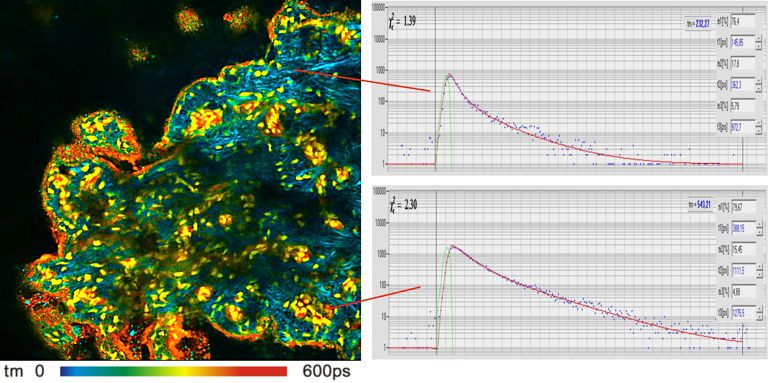The bh FLIM systems for the Zeiss LSM 710 / 780 / 880 laser scanning microscopes record high-efficiency FLIM and FCS with the Zeiss BiG 2 detectors. The detectors feature high efficiency, low thermal background, and low afterpulsing. They can be used for confocal FLIM with excitation by ps diode lasers, multiphoton FLIM with excitation by a Ti:Sa laser or an OPO, and for FCS. Separate images are detected in both channels of the BiG 2 detector and recorded simultaneously by the two parallel channels of the FLIM system. With bh’s recently introduced Megapixel FLIM technology data formats of up to 2048 x 2048 pixels, with 256 time channels per pixel can be used. Images can thus be recorded at diffraction-limited resolution over the full field of view of the microscope lens. FCS is recorded at high signal-to-noise ratio, without any signs of spurious signals. FCCS is obtained by cross-correlating the signals of the two detector and TCSPC channels. For more details please see application note ‘Zeiss BiG-2 GaAsP Detector is Compatible with bh FLIM Systems‘, FLIM Upgrades for Zeiss and Handbook of bh FLIM systems for Zeiss LSM 710/780/880 laser scanning microscopes.
Fresh pig skin stained with methylen blue. Left: FLIM image, 512x512 pixels, amplitude-weighted lifetime of triple-exponential decay. Middle Left: Fluorescence decay curves in two selected spots of the image. Two-photon excitation by OPO at 1100 nm, non-descanned detection by BiG-2 detector. Middle Right and Right: Fluorescence decay functions and FCS curves detected in the two channels of the BiG-2 detector. Atto 425, excitation by 405 nm ps diode laser. bh Simple-Tau 152 dual-channel FLIM system. The red curve is a fit with two diffusion terms and a triplet term.


